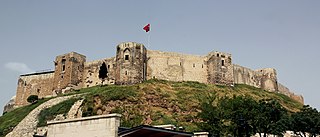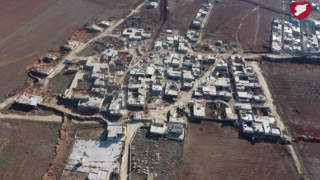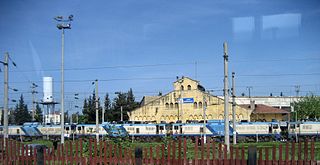
Gaziantep, historically Aintab and still informally calledAntep, is a major city in south-central Turkey. It is the capital of the Gaziantep Province, in the westernmost part of Turkey's Southeastern Anatolia Region and partially in the Mediterranean Region. It is located approximately 185 km (115 mi) east of Adana and 97 km (60 mi) north of Aleppo, Syria and situated on the Sajur River. The city is thought to be located on the site of ancient Antiochia ad Taurum and is near ancient Zeugma.

Ceyhan is a municipality and district of Adana Province, Turkey. Its area is 1,426 km2, and its population is 158,922 (2022). It is the most populous district of the province, outside the city of Adana. Ceyhan is the transportation hub for Middle Eastern and Central Asian oil and natural gas. The city is situated on the Ceyhan River that flows through Çukurova plain. The Ceyhan River is dammed at Aslantas to provide flood control and irrigation for the lower river basin around Ceyhan.

The Baghdad railway, also known as the Berlin–Baghdad railway, was started in 1903 to connect Berlin with the then Ottoman city of Baghdad, from where the Germans wanted to establish a port on the Persian Gulf, with a 1,600-kilometre (1,000 mi) line through modern-day Turkey, Syria, and Iraq.

General Establishment of Syrian Railways is the national railway operator for the state of Syria, subordinate to the Ministry of Transportation. It was established in 1956 and was headquartered in Aleppo. Syria's rail infrastructure has been severely compromised as a result of the ongoing conflict in the country.

The Adana–Mersin Main Line is a 67 km long double track rail line from the Adana Railway Station in Adana to the Mersin Railway Station in Mersin. The line passes through the city of Tarsus and has branch lines to the Port of Mersin. The line is one of the busiest rail lines in Turkey with 57 passenger trains and about 20 freight trains daily.

The State Railways of the Republic of Turkey, abbreviated as TCDD, is a government-owned national railway company responsible for the ownership and maintenance of railway infrastructure in Turkey, as well as the planning and construction of new lines. TCDD was formed on 4 June 1929 as part of the nationalisation of railways in Turkey.

Mersin station is the main railway terminal in the city of Mersin, Turkey. The station is located in the ilçe (district) of Akdeniz. The station is in use since 1886.

Adana station is a railway station in Adana and one of the major railway hubs in Turkey. The station is located at the İstasyon Square, in Kurtuluş, Seyhan.

Tarsus station is a railway station in the city of Tarsus. Tarsus is a city in Mersin Province, Turkey.
Mersin Province is a Mediterraneran province of Turkey. The south eastern plain of the province is a part of Çukurova. But most of the province is mountainous with a number of small alluvial plains at the coastal band. Below are the transport facilities of the province.

The Varda Viaduct, aka Giaour Dere Viaduct, locally known as "Alman Köprüsü" or "Koca Köprü", is a railway viaduct situated at Hacıkırı (Kıralan) village in Karaisalı district of Adana Province in southern Turkey. Designed and built by Imperial German engineers as part of the Baghdad Railway, the stone arch structure is 63 km (39 mi) from Adana Central Station and 306 km (190 mi) from Konya.
Menagh is a town near Azaz 16 km North of Aleppo in northwestern Aleppo Governorate of northern Syria.

Maraanaz is a village near Azaz in northwestern Aleppo Governorate of northern Syria.

İskenderun station is the main railway station in the city of İskenderun, Turkey. The station is located at 36°35′18″N36°10′54″E. The bus station is to the south west and the harbor is to the north of the station. İskenderun is a port city in the Hatay Province and the station is the southern terminus of the Toprakkale-İskenderun branch line which connects the province to the main line between Adana and Gaziantep. The line was opened to service in 1913 during the Ottoman Empire era.

The Konya–Yenice railway is a 344.7 km (214.2 mi) long, partially electrified railway in southern Turkey. The railway is a major route connecting Turkey's Mediterranean coast to the Anatolian interior as well as the only railway line through the Taurus Mountains. The line begins in Konya and runs southeast through Karaman until turning south at Ulukışla and joining the Adana–Mersin railway at Yenice. The section between Konya and Karaman is classified as a High-standard railway, while the rest of the route is classified as a Conventional railway.

The Adana-Aleppo railway is a 297.4 km (184.8 mi) long electrified railway mostly in southern Turkey. The railway begins in Adana and heads east through Osmaniye, then turns south after crossing the Nur Mountains and runs into Syria. Due to the outbreak of the Syrian Civil War in 2011, the 118 kilometres (73 mi) portion of the route within Syria is mostly abandoned and in disrepair. On the Turkish side, trains run as far south to İslahiye, about 22 km (14 mi) north of the Syrian border. While the tracks south of İslahiye to the border are maintained, no scheduled trains currently run on them.
The Ayran Tunnel, also known as the Amanus Tunnel or Bahçe Tunnel, is a 4,905 m (16,093 ft) long railway tunnel in southern Turkey. It carries the Adana-Aleppo railway through the Nur Mountains, at the eastern end of the Amanian Gate. Built by the Baghdad Railway between 1908 and 1917, the tunnel is currently owned by the Turkish State Railways. The tunnel begins just east of Bahçe and ends just north of Fevzipaşa.
The Nurdağı Tunnel is a 9,950 m (32,640 ft) long twin-tube railway tunnel, currently under construction in southern Turkey. Passing through the Nur Mountains, near the east end of the Amanian Gate, it will carry passenger and freight trains along with high-speed trains, as part of the Mersin-Adana-Gaziantep high-speed railway. Upon completion, it will become the longest railway tunnel in Turkey, surpassing the 5,473 m (17,956 ft) long Deliktaş Tunnel in Sivas.
The Nurdağı-Başpınar railway is a 56 km (35 mi) long electrified high-speed railway under construction in southern Turkey. Branching off the Fevzipaşa-Kurtalan railway at Nurdağı, the railway will connect to the Narlı-Karkamış railway at Başpınar, a northern suburb of Gaziantep. The railway is part of the larger Mersin-Adana-Gaziantep high-speed railway project, in which the existing Mersin-Adana and Adana-Bahçe railways are being upgraded to accommodate speeds between 160 km/h (99 mph) and 200 km/h (120 mph), along with the 17 km (11 mi) long Fevzipaşa bypass. When completed, the railway will accommodate mostly high-speed trains but also conventional passenger and freight trains and is classified as a high-standard railway.
The Mersin–Adana–Gaziantep high-speed railway, known officially as the Mersin–Adana–Gaziantep higher-speed railway and abbreviated as MAG, is a 303 km (188 mi) long high-speed/higher-speed railway corridor currently under construction in southern Turkey. Beginning at Mersin, on the Mediterranean Sea, the railway corridor stretches inland to Gaziantep, via Yenice, Adana and Osmaniye. The scope of the project includes the upgrading of three existing railway lines, the construction of a new railway tunnel bypass, and the construction of a new, direct rail-link to Gaziantep.














